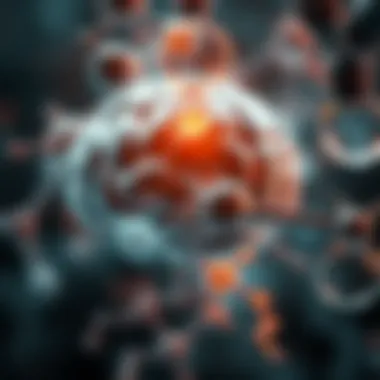Assessing Topamax's Role in Depression Treatment


Intro
As we navigate the intricate landscape of mental health treatment, the consideration of diverse medications can offer new avenues for relief. One such medication is Topamax, primarily recognized for its role in epilepsy management and migraine prevention. Nevertheless, intriguing developments have emerged suggesting its potential efficacy for treating depression—a condition that continues to debilitate millions globally. This article aims to illuminate the promising yet underexplored intersection of Topamax and mood disorders, providing a thorough examination of current research, patient experiences, and the biochemical mechanisms that could support its use.
The relevance of this topic cannot be overstated; mental health challenges are on the rise. Depression, with its multifaceted causes and manifestations, often necessitates innovative treatment approaches. While traditionally labeled as an anticonvulsant, the potential repurposing of Topamax invites scrutiny and deeper understanding, particularly as emerging studies hint at its usefulness beyond epilepsy management.
By delving into this uncharted territory, we open the door to a more comprehensive understanding of how existing medications can be leveraged to address a broader spectrum of mental health issues. This exploration is both timely and crucial, offering valuable insights for students, researchers, educators, and professionals keen on expanding their knowledge in psychiatric pharmacology.
Prolusion
The exploration of alternative medications for depression is a matter of increasing interest, particularly as traditional therapies sometimes fall short in effectiveness or present unwanted side effects. In this context, Topamax, traditionally prescribed to manage epilepsy and migraines, is evolving into a topic worthy of deeper investigation. Understanding the interplay between this medication and mood disorders not only opens new therapeutic avenues, but it could also provide relief for individuals who struggle to find help in existing treatment options.
Importance of Topamax in the Discussion
Topamax, or topiramate, is not typically associated with treating depression, but recent findings hint at its potential impact on mood stabilization. This article will discuss not only how the drug works biochemically, affecting neurotransmitter systems, but also examine emerging clinical insights that challenge conventional usage paradigms. By diving into the connections between epilepsy, migraines, and mood fluctuations, we can better appreciate the broader implications of introducing a medication primarily designed for other conditions into the realm of mental health.
The issues faced by individuals suffering from depression often extend beyond just mood disturbances. There may be co-occurring conditions that complicate treatment. In addressing these complexities, Topamax's off-label use could prove to be a lifesaver for some. While there's much to unpack—from existing research studies to anecdotal evidence—this piece aims to provide a comprehensive analysis that might illuminate paths that had previously been overlooked.
Overall, examining the efficacy of Topamax in treating depression represents a critical juncture at which pharmacological innovation intersects with patient experience. As we navigate this topic, we will highlight key aspects, from biochemical mechanisms to clinical outcomes, laying the groundwork for understanding its role in broader treatment paradigms.
"The shifting landscapes of medicine often reveal new pathways for healing; Topamax might just be one of them."
"The shifting landscapes of medicine often reveal new pathways for healing; Topamax might just be one of them."
In this article, we'll delve into the specifics of Topamax's mechanisms, its historical context, and the patient narratives that enrich its profile in mental health treatment. As we peel back the layers, we aim to foster an informed discussion that may resonate with clinicians, researchers, and anyone grappling with the nuances and complexities of depression.
Mechanisms of Action
Understanding the mechanisms of action for Topamax in the context of treating depression is essential. This medication, while primarily known for managing epilepsy and migraines, operates through complex biochemical pathways that can influence mood disorders. The way Topamax affects neurotransmitter systems and its interaction with various biological processes can shed light on its potential as a treatment for depression. By delving into these mechanisms, one can appreciate not only how Topamax works but also the possible implications for those suffering from mood disorders.
Impact on Neurotransmitter Systems
The influence of Topamax on neurotransmitter systems is a critical area of exploration. Neurotransmitters are the chemical messengers in the brain, and they play vital roles in mood regulation. Two key components to consider are Gamma-Aminobutyric Acid (GABA) and glutamate. Understanding how Topamax alters the balance of these neurotransmitters can provide insights into its efficacy in combating depression.
Gamma-Aminobutyric Acid (GABA)
Gamma-Aminobutyric Acid, known as GABA, is recognized for its inhibitory effects within the brain. One of the key characteristics of GABA is its ability to calm neural activity, which can be particularly advantageous in environments where anxiety and stress are prevalent. In the context of depression, increased GABA activity may help alleviate some of the heightened emotional responses associated with the condition.
Topamax enhances the effectiveness of GABA, providing a more sustained calming effect. This is beneficial for individuals who often find their mood swings exacerbated by anxiety. However, it's also necessary to consider that too much GABA could lead to a sedative effect, possibly impacting daily functioning. Therefore, the careful measurement and monitoring of GABA levels are crucial when using Topamax in the treatment of mood disorders.
Glutamate Regulation
Glutamate is the most abundant excitatory neurotransmitter in the brain, playing a vital role in learning and memory, but its overstimulation isn't always beneficial. A key aspect of glutamate regulation is its dual nature; while it's essential for cognitive function, excessive glutamate activity can lead to excitotoxicity, which may contribute to neurodegenerative processes. Topamax works by modulating the levels of glutamate, effectively reducing this overstimulation.


This regulation is particularly pertinent when considering mood disorders, as imbalances in glutamate have been associated with both depression and anxiety. By normalizing glutamate activity, Topamax can potentially help stabilize mood and support emotional well-being. However, the unique aspect of glutamate modulation must be approached with caution, as there can be a fine line between achieving therapeutic benefits and inducing adverse effects from over-correction.
Effects on Mood and Anxiety
The interplay between the mechanisms of action of Topamax and their effects on mood and anxiety presents an intriguing avenue for treatment outcomes. Patients often report varied experiences—some find relief from depressive symptoms, while others may not notice significant changes.
Research suggests that the balancing act between GABA and glutamate may ease both anxiety and depressive symptoms. This dual action is thought to pave the way for integrating Topamax into broader therapeutic strategies. As professionals consider its use, it’s important to look deeper into how individual variations in neurotransmitter systems might respond to Topamax. Ultimately, a tailored approach could enhance the therapeutic experience for those grappling with mood disorders.
Clinical Insights
The section on Clinical Insights aims to shed light on the emerging role of Topamax, not just as an anticonvulsant, but as a potential adjunctive treatment for depression. This shift in understanding highlights the need for healthcare professionals to explore off-label uses of existing medications. Given the unique intersection of neurological conditions and mood disorders, examining the efficacy of Topamax in this realm is essential for developing comprehensive treatment strategies. It opens the door for innovative approaches that can enhance patient outcomes, thereby impacting a broad spectrum of mental health care.
Research Studies on Topamax and Depression
Findings from Observational Studies
Findings from observational studies regarding the use of Topamax in treating depression are particularly noteworthy. These studies often focus on specific patient populations, providing real-world insights into the drug's impact on mood regulation. One key characteristic of these studies is that they tend to highlight variations in individual responses to Topamax, making them a rich resource for understanding how and why this medication might work in some cases, yet not in others. This characteristic makes observational studies a beneficial choice, as they capture the nuances of real-life scenarios.
Moreover, these studies frequently underscore the importance of monitoring not only depression symptoms but also any possible side effects that patients experience while on Topamax. This dual focus is advantageous, as it can inform clinicians about the value of incorporating Topamax into a broader treatment regimen, particularly for patients with chronic ailments who also experience mood disorders. However, care must be taken when interpreting findings, because these studies may be influenced by confounding factors.
Meta-analyses Overview
The overview of meta-analyses presents a broader perspective on the efficacy of Topamax for treating depression. These analyses can combine results from multiple studies, delivering a more comprehensive understanding of the medication's effects across different patient populations. A key characteristic of these meta-analyses is their ability to quantify the overall impact of Topamax, potentially identifying trends that may not surface in smaller, single studies. This collective approach is highly beneficial, offering clinicians valuable insights into the overall effectiveness of the treatment.
One unique feature of meta-analyses is their capacity to identify specific demographics or baseline characteristics that predict better or worse outcomes with Topamax. This could be particularly useful for tailoring treatment plans. However, one must also consider that the quality of individual studies included in the meta-analysis can greatly influence the overall conclusions drawn, posing a challenge in terms of reliability.
Case Studies and Patient Reports
Delving into individual case studies and patient reports provides further depth in investigating the efficacy of Topamax for treating depression. These narratives often reveal a tapestry of personal experiences, highlighting not just the clinical data but also the emotional and psychological landscapes that shape treatment outcomes. While these stories can be quite informative, they are admittedly subjective and may not always represent the typical experience. However, they can spark conversation among healthcare providers about the drug's application in less conventional circumstances. Furthermore, patient-centric accounts can play a vital role in fostering understanding about how various conditions and treatments interact.
"Real patient experiences often illuminate aspects of treatment that numbers and graphs cannot. These stories can motivate a rethink of the path we tread in psychiatry."
"Real patient experiences often illuminate aspects of treatment that numbers and graphs cannot. These stories can motivate a rethink of the path we tread in psychiatry."
In summary, the Clinical Insights section aims to bridge the gap between empirical studies and the human experience of depression treatment. Through the exploration of observational studies, meta-analyses, and personal accounts, a holistic view of the potential of Topamax can be formed, guiding both patients and healthcare professionals toward informed decisions.
Potential Benefits
The exploration of Topamax for treating depression presents intriguing possibilities worth considering. Given its primary usage for epilepsy and migraine management, the medication's role in mental health brings a fresh perspective to a field often dominated by traditional antidepressants. Many are curious about how this atypical approach could yield significant therapeutic benefits.
Efficacy Compared to Traditional Antidepressants
In recent years, there has been an increasing interest in examining the efficacy of Topamax in comparison with standard antidepressants like selective serotonin reuptake inhibitors (SSRIs). One notable benefit is the distinct mechanism by which Topamax operates. Unlike SSRIs, which primarily target serotonin levels, Topamax also influences the GABA and glutamate neurotransmitter systems. This dual action might help to address a wider array of underlying causes of depression, providing a unique treatment pathway. Although clinical trials specific to depression remain limited, existing studies, such as those noted by the National Institute of Mental Health, suggest that some patients experience improved mood regulation and reduced anxiety indicators when using Topamax.
Benefits for Co-existing Conditions
Attention is also drawn to how Topamax might benefit individuals with co-existing conditions, particularly anxiety disorders and chronic pain conditions.


Anxiety Disorders
Anxiety disorders often coexist with depression, complicating diagnosis and treatment. The interplay of these two mental health challenges can create a cycle of symptoms that exacerbate one another. A key characteristic of anxiety disorders is heightened arousal and persistent worry, which can be debilitating for many. Topamax's anxiolytic properties may provide a two-for-one benefit, addressing both anxiety levels and mood stabilization. The unique feature here is how Topamax can effectively reduce instances of anxiety without the heavy side effects typically associated with traditional anti-anxiety medications.
Chronic Pain Conditions
Chronic pain conditions, like fibromyalgia or arthritis, are another area where Topamax has shown potential. Those suffering from chronic pain often report accompanying depressive symptoms. Here, the efficacy of Topamax could extend beyond mood improvement; by potentially alleviating pain, it addresses a significant source of emotional distress. The ability to manage pain and mood in one go makes Topamax an intriguing option, especially for patients seeking a holistic approach to treatment. Still, one must be aware of the drug's side effects that include cognitive effects, which, while manageable, could pose challenges for some individuals.
Ultimately, the potential benefits of employing Topamax in treating depression are multifaceted, fostering a broader understanding of mood disorders and their intersections with anxiety and chronic pain.
Side Effects and Considerations
When discussing the topic of Topamax in treating depression, it is crucial to shed light on the side effects and considerations surrounding its use. Patients often weigh the benefits of any medication against its potential downsides, and this is especially true with Topamax. Understanding its side effects can enlighten users about what to expect and choose the right course of treatment.
Common Side Effects of Topamax
Topamax, like many medications, comes with its own set of side effects. Being aware of these side effects can assist in deciding whether this medication fits into one’s mental health management plan.
Cognitive Effects
One of the prominent cognitive effects associated with Topamax includes difficulties with concentration and memory. Patients have reported experiencing what they often call "brain fog." This refers to a state of mental cloudiness which can hamper day-to-day activities.
- This aspect is quite pivotal as cognitive function is directly tied to quality of life. If a treatment impacts someone's ability to think clearly or remember simple tasks, that could lead to frustration and decreased productivity.
- The unique characteristic of cognitive effects rests in its episodic nature; some individuals might not feel these effects consistently, leading to unpredictability.
On the flip side, some users find that these cognitive effects diminish as they continue the medication. This potential for adaptation can be a saving grace for individuals determined to combat their depression with a medication that might offer relief.
Physical Health Implications
Topamax also holds implications for physical health. Some common physical side effects include fatigue, weight loss, and tingling sensations in extremities, known as paresthesia. These physical manifestations may not seem directly tied to mood but can significantly affect overall well-being.
- The key characteristic of these physical effects is their potential to compound existing conditions. For instance, weight loss could be detrimental for someone already struggling with an eating disorder.
- Understanding these can be beneficial because it allows patients to prepare and engage consistently with healthcare providers regarding any unravelling health issues that might occur.
However, while the tingling sensation can sound alarming, it can sometimes serve as a reminder for individuals to stay mindful about their health and discuss issues with their doctors.
Long-term Usage Implications
Considering long-term usage of Topamax introduces additional dynamics to the conversation. Long-term impacts may include a risk of kidney stones and metabolic acidosis, which can occur when the body produces too much acid. Not all patients experience these complications, but it’s crucial to be in continuous communication with a healthcare professional to monitor for these possibilities.
Some patients may find that taking Topamax for an extended duration helps in preventing recurrence of depressive episodes. Yet, establishing a consistent monitoring schedule with a healthcare provider is essential to ensure that potential risks are managed.
In summary, while Topamax might be a viable option for treating depression, the associated side effects and considerations could make or break the experience. Patients should tread carefully, comprehensively weighing the pros and cons, and take proactive steps in consulting with healthcare professionals.
Alternatives and Integrative Approaches


When it comes to addressing depression, relying solely on pharmacological interventions like Topamax can overlook the multifaceted nature of mood disorders. The exploration of alternatives and integrative approaches is thus crucial. Understanding these methods often leads to more personalized care, bridging the gaps that traditional modalities might leave behind. In this section, we will discuss medications traditionally used for depression and examine mind-body strategies that offer a holistic avenue for treatment.
Other Medications for Depression
Not all individuals respond favorably to the same antidepressants. As a result, it's essential to recognize a variety of medications that can be effective alternatives. Commonly used antidepressants include selective serotonin reuptake inhibitors (SSRIs) like Fluoxetine (Prozac) and Sertraline (Zoloft), which manage serotonin levels, and serotonin-norepinephrine reuptake inhibitors (SNRIs) like Venlafaxine (Effexor). In some cases, healthcare providers may prescribe atypical antidepressants such as Bupropion (Wellbutrin) or Mirtazapine (Remeron) when standard options fail.
However, it’s significant to evaluate not only the efficacy but also the side effects tied to these medications. While SSRIs and SNRIs come with a relatively good safety profile, some patients report sexual dysfunction or weight gain, which can lead to medication discontinuation. Considering patient reports and clinical findings reinforces the notion that treatment should be tailored to the individual’s unique circumstances and health history.
Complementary Therapies
Complementary therapies enhance recovery and can make a striking difference in overall treatment outcomes. Here, we delve into two effective approaches: psychotherapy and mindfulness practices, detailing their contributions and advantages.
Psychotherapy
Psychotherapy, commonly known as talk therapy, plays a pivotal role in managing depression. Cognitive Behavioral Therapy (CBT) is a notable type, focusing on reshaping negative thought patterns that can exacerbate depressive symptoms. The core characteristic of psychotherapy lies in its interactive nature, allowing individuals to articulate their feelings and thoughts while receiving professional guidance. This might be seen as a remarkable entry point for many, fostering insights and empowering clients with effective coping mechanisms.
One unique feature of psychotherapy is its adaptability; it can be conducted in various formats such as individual, group, or family settings. This adaptability caters to different preferences and underscores the idea that not all journeys through depression are linear. It's important to note that while psychotherapy has significant advantages, including lasting emotional support and self-discovery, it may not provide immediate relief, thus appealing to those who appreciate deeper, sustained forms of healing.
Mindfulness Practices
Mindfulness practices encompass a range of techniques aimed at enhancing present-moment awareness. This approach promotes emotional regulation and fosters an observant and accepting mindset regarding one’s feelings. Key aspects include mindfulness meditation, yoga, and deep-breathing exercises, which can assist individuals in becoming more aware of their thoughts and feelings, reducing rumination.
The essence of mindfulness practices is their emphasis on self-compassion and acceptance; hence, they are increasingly recognized as beneficial avenues for those grappling with depression. A unique feature of mindfulness is its non-judgmental stance, encouraging individuals to observe their experiences without the pressure to change them immediately. The documented advantages include improved emotional resilience and decreased stress levels. However, some individuals may find the practice challenging initially, as it requires consistent effort and patience to witness tangible benefits.
In summation, integrating alternatives and complementary therapies alongside conventional treatments can enrich the overall approach to managing depression. Emphasizing multiple pathways to healing provides a broader lens through which individuals can evaluate their mental health journey.
End
In this article, we have examined the potential role of Topamax in treating depression, even though it is primarily known for its use in managing epilepsy and migraines. Understanding its efficacy is crucial, as many patients, sometimes feeling stuck between traditional antidepressants and the lingering weight of depression, might find a glimmer of hope in this unconventional medication.
Summary of Findings
The findings we discussed underscore Topamax's unique position in the realm of mental health. Notably, while the medication is not standard treatment for depression, the data emerging from various studies hints at several advantages:
- Neurotransmitter Balance: Topamax influences neurotransmitter systems, especially by regulating GABA and glutamate, which are pivotal in mood regulation.
- Patient Experiences: Anecdotal evidence from patients illustrates potential benefits, where users report improvements in mood, sometimes even when conventional treatments fall short.
- Efficacy vs. Traditional Antidepressants: Unlike traditional antidepressants like SSRIs, which may take weeks to show effects and come with a laundry list of side effects, Topamax offers an intriguing alternative that some find beneficial.
To highlight a crucial insight, consider this:
"Understanding alternative pathways in depression treatment can empower both patients and practitioners, allowing for a more personalized approach to mental wellness."
"Understanding alternative pathways in depression treatment can empower both patients and practitioners, allowing for a more personalized approach to mental wellness."
Future Research Directions
The exploration of Topamax for treating depression is still in its infancy, and several routes remain to be charted:
- Longitudinal Studies: More extensive, long-term studies could provide deeper insights into the drug’s effects over time, clarifying its role in mood disorders.
- Comparative Research: Direct comparisons with both SSRIs and SNRIs will determine Topamax's efficacy and safety profile relative to established options.
- Mechanism Exploration: Delving deeper into the biochemical pathways influenced by Topamax could unveil mechanisms that might be harnessed to develop new therapeutic strategies.
Recognizing these directions will not only enhance our understanding of Topamax but could pave the way for innovative treatments that align with the nuances of mental health care. As new studies emerge, both the medical community and patients will be better equipped to make informed decisions about treatment possibilities.







